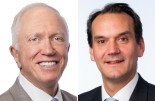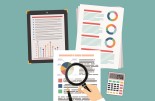Blue Bay AM: Identifying the turning point

By Mark Dowding, CIO at BlueBay AM
Concerted ECB efforts bring us one step closer to anchoring yields as we remind ourselves that fear is never a permanent state.
Financial markets have remained under extreme pressure during the past week, on the dawning realisation that Europe and the US face months of economic impairment and substantial social costs in the light of the ongoing spread of Covid-19.
With transmission rates running higher than hoped, the need to take mitigating action to alleviate the forthcoming stress on the healthcare sector means that countries are sequentially moving into a lockdown setting. Everyday life is set to be materially curtailed over the course of the next several months.
Equity markets have continued to plunge as investors discount a global recession and price action in financial markets has become increasingly erratic as liquidity dries up, with traders forced to work from home.
Although the extent of the recent sell-off is yet to match that which occurred in the global financial crisis in 2008, the speed of moves has been startling. Equity markets have fallen by more than 30% in three weeks while credit spreads in corporate bonds, high yield, structured credit and emerging markets have trebled. Volatility indicators such as the VIX index have increased by a multiple of six times.
The speed of moves has made it difficult for material risk transfer to take place and understandably stop-loss triggers have seen some assets fall dramatically in price on relatively little volume.
Living in unprecedented times
Few of us expected to ever find ourselves queueing for food or explaining to our elderly relatives why we can’t come and visit them due to the need to self-isolate. Yet away from the chaos, we believe that it is right to be asking what conditions we believe we need to see in order for markets to reach a turning point.
There are several observations we are tempted to make.
Analysing the Kubler-Ross model, we feel that we are now largely transitioning beyond the shock and denial phases of the cycle and therefore the low point should not conceptually be too far from sight.
There may be a sense that in the US, attitudes still have further to go in order to adjust – but across Europe, it seems like society is now quickly coming to terms with the unfolding crisis.
Secondly, we would observe that policymakers are starting to shake off some of their initial complacency and are trying to move beyond a reactionary response to markets, to one in which they are more determined to show leadership.
Material fiscal easing is now being announced, central banks have cut rates, boosted QE and announced a range of additional measures.
Importantly, in the eurozone, it seems that the ECB has woken up to its communication mistakes, which had threatened to undermine the fabric of the region, in the wake of Lagarde’s disastrous performance last week.
The final element, which we now believe will be required, is evidence that the rate of infection and then death is starting to level out. For now, further acceleration in both numbers is inevitable, but as the rate of change starts to slow, then it seems reasonable for markets to try to extrapolate a turning point being reached.
Approaching a change of direction
We believe that we have moved much closer to – but have not quite reached – a definitive turning point in all markets just yet.
In the eurozone, we are now more optimistic that concerted efforts by the ECB can anchor yields across the bloc. We had argued that the correct policy response would be largely fiscal, with monetary policy backstopping yields in order to promote more stimulative financial conditions.
In some respects, this could follow a BoJ-like move towards yield curve control in a co-ordinated fiscal and monetary response.
We have also thought that the payment of universal income (as already seen in Hong Kong) could represent an innovative policy step in the form of ‘fiscal helicopter money’, but that this would need a central bank back-stop in order to cap any move in yields or spreads associated with worries relating to rising debt levels.
Consequently, we are hopeful that with a further EUR750bn PEPP asset-purchase programme coming on top of existing QE and the additional sum of EUR120bn announced last week, the ECB should be in a good position to control yields.
Including Greece in this programme, seemingly scrapping the previous 33% issue limits and articulating that the ECB would go even further in order to ensure appropriate credit transmission within the eurozone, showed a degree of decisiveness, which was sorely absent in last week’s laissez faire and nonchalant comments with respect to bond spreads in the region.
In this context, we believe that euro sovereign spreads should now be contained and volatility in the region should start to fall. This should also permeate euro investment-grade corporates and financials.
The challenge of liquidity
The ongoing need for USD liquidity has seen spreads remain under pressure, notwithstanding the introduction of Fed swap lines.
Funding problems have forced the closure of many relative value positions across markets, meaning that ‘off the run’ securities have become increasingly difficult to trade.
Fund redemptions have also added to stress, with some high-profile fixed income managers down as much as 50% on a year-to-date basis.
Emerging markets have also continued to experience dislocations, with the price of Brent crude dropping below USD25 for the first time since 2002.
Even more surprising, liquidity has dried up in the normally liquid foreign exchange market. With much trade being centred in London, so moves towards placing the city on lockdown, with traders moving to work from home, has triggered a scramble to close trades leading to some out-sized moves in currencies such as the Norwegian krone and the British pound, where consensus positioning had been overweight since last year’s general election.
Fear is not permanent
As we survey the landscape, there is a sense that coronavirus is all that currently matters. However, fear is not a permanent state in markets (nor in life). It is a transitionary phase and life will return to normal once we are out of the other side.
In 1919, this was true even in the wake of the Spanish flu pandemic, coming on the heels of the First World War. We also hold to the belief that, as quick as was the descent into recession, so will be the recovery once it takes place.
We don’t believe there is excess leverage in the system, as was the case of 2008. Banks are in decent shape and there need not be structural impediments holding back growth once we pass this particular episode.
There are question marks whether this recovery will start to occur in three or 12 months from now, yet it strikes us that it is now far too late to consider cutting risk and the next trade should be to add – albeit, in liquid instruments to begin with.
Correctly identifying a turning point is never easy and this will often occur around a point of maximum bearishness, when making such a call feels counter-intuitive. However, experience reminds us that the best time to buy is when others are panicking to sell and although we want to be prudent in managing overall portfolio risk levels, we will also want to capitalise on this opportunity as it presents itself.
On this note, it is interesting to observe how in Italy there has been no panic buying in the shops and the country is a picture of relative calm in contrast to some of the hysteria being witnessed in stores in the UK. An interesting study in crowd behaviour and psychology indeed.










